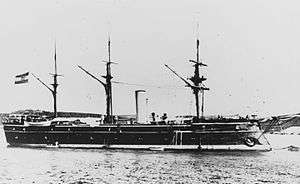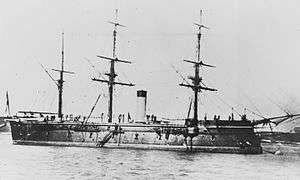Erzherzog Ferdinand Max-class ironclad
 Erzherzog Ferdinand Max in the 1880s | |
| Class overview | |
|---|---|
| Operators: |
|
| Preceded by: | Kaiser Max class |
| Succeeded by: | SMS Lissa |
| Built: | 1863–1866 |
| In commission: | 1866–1898 |
| Completed: | 2 |
| Scrapped: | 2 |
| General characteristics | |
| Displacement: | 5,130 metric tons (5,050 long tons; 5,650 short tons) |
| Length: | 83.75 meters (274.8 ft) oa |
| Beam: | 15.96 m (52.4 ft) |
| Draft: | 7.14 m (23.4 ft) |
| Installed power: | 2,925 indicated horsepower (2,181 kW) |
| Propulsion: | 1 single-expansion steam engine |
| Speed: | 12.54 knots (23.22 km/h; 14.43 mph) |
| Crew: | 511 |
| Armament: |
|
| Armor: |
|
The Erzherzog Ferdinand Max class consisted of a pair of ironclad warships—Erzherzog Ferdinand Max and Habsburg—built for the Austrian Navy in the 1860s. They were the last broadside armored frigates to be built for the Austrian Empire, and the last vessels completed to see action against the Italians at the Battle of Lissa in 1866. Intended to have been armed with new breech-loading Krupp guns, the outbreak of the Seven Weeks' War prevented the delivery of the guns, forcing the Austrian Navy to arm the ships with a battery of sixteen older 48-pounder muzzle-loading guns.
Hastily finished after the war started, both ships saw action at the Battle of Lissa in July. There, Erzherzog Ferdinand Max served as the flagship of Rear Admiral Wilhelm von Tegetthoff; in the course of the melee, the ship rammed and sank the Italian ironclad Re d'Italia, which proved to be the decisive action in the battle. After the war, both ships were laid up and did not see much significant activity for the remainder of their careers owing to reduced naval funding in what had become the Austro-Hungarian Empire. The ships were converted for secondary duties in 1886, Erzherzog Ferdinand Max and Habsburg became a tender and a guard ship, respectively. Habsburg was sold for scrap in 1898, but Erzherzog Ferdinand Max lingered on until 1916, when she joined her sister in the breaker's yard.
Design
Following the launch of the French Gloire, the first ironclad warship, the Austrian Navy began a major ironclad construction program under the direction of Archduke Ferdinand Max, the Marinekommandant (naval commander) and brother of Kaiser Franz Josef I. In 1861, the first five ships—two Drache and three Kaiser Max-class ironclads—were laid down.[1][2] All of these ships were designed by the Director of Naval Construction Josef von Romako, who also prepared the design for what became the Erzherzog Ferdinand Max class, named for the Marinekommandant.[3] These two ships were significantly larger than the Drache and Kaiser Max-class vessels, and were originally intended to carry thirty-two 48-pounder muzzle-loading guns, though during the construction process the Navy decided to opt for a battery of new breech-loading guns manufactured by Krupp. The outbreak of the Seven Weeks' War in 1866 forced the Navy to hastily complete them with only sixteen of the original 48-pounders.[3][4]
General characteristics and machinery
The Erzherzog Ferdinand Max-class ships had a similar appearance to the French Gloire. They were 79.97 meters (262.4 ft) long between perpendiculars and 83.75 m (274.8 ft) long overall. They had a beam of 15.96 m (52.4 ft) and an average draft of 7.14 m (23.4 ft). They displaced 5,130 metric tons (5,050 long tons; 5,650 short tons). The hulls were of wooden construction, and were sheathed with wrought iron armor that was 123 mm (5 in) thick on the battery and reduced to 87 mm (3.4 in) at the bow and stern. The ships had a crew of 511 officers and enlisted men.[3]
Their propulsion system consisted of one single-expansion, 2-cylinder, horizontal steam engine that was manufactured by the Stabilimento Tecnico shipyard in Fiume. The engine drove a single screw propeller. The number and type of their coal-fired boilers have not survived, though they were trunked into a single funnel located amidships. Their engines produced a top speed of 12.54 knots (23.22 km/h; 14.43 mph) from 2,925 indicated horsepower (2,181 kW). Each ship was originally fitted with a three-masted rig to supplement the steam engines.[3]
Armament
The ships of the Erzherzog Ferdinand Max class were broadside ironclads, and they were armed with a main battery of sixteen 48-pounder muzzle-loading guns. These were carried in the traditional broadside arrangement of earlier ships of the line. They also carried several smaller guns, including four 8-pounder guns and two 3-pounders. Over the course of their career, their armament was revised several times. The old muzzle-loaders were replaced with a battery of fourteen 8 in (203 mm) Krupp guns in 1869. In 1874 they were rearmed with a battery of fourteen 7 in (180 mm) muzzle-loading Armstrong guns and four light guns. Their battery was revised again in 1882, with the addition of four 9 cm (3.5 in) breech-loader guns, two 7 cm (2.8 in) breech-loaders, a pair of 47 mm (1.9 in) quick-firing revolver guns, and three 25 mm (0.98 in) auto-cannons.[3]
Ships
| Name | Builder[3] | Laid down[3] | Launched[3] | Completed[3] |
|---|---|---|---|---|
| Erzherzog Ferdinand Max | Stabilimento Tecnico Triestino, Trieste | 6 May 1863 | 24 May 1865 | July 1866 |
| Habsburg | June 1863 | 26 June 1865 |
Service history

Both ships were still under construction at the outbreak of the Seven Weeks' War in June 1866; the shipyard workers quickly completed the vessels, albeit with old smooth-bore guns instead of the Krupp rifled breech-loaders that were intended. Erzherzog Ferdinand Max served as the flagship of the Austrian fleet under Rear Admiral Wilhelm von Tegetthoff.[5] The two ships saw action at the Battle of Lissa in July 1866, where Erzherzog Ferdinand Max rammed and sank the Italian ironclad Re d'Italia. This proved to be the turning point of the engagement, forcing the Italian commander, Admiral Carlo Pellion di Persano to withdraw. Habsburg, however, was not seriously engaged during the battle. Neither ship received significant damage in the battle,[6] and they spent the rest of the war patrolling the Adriatic against a possible sortie from the Italian fleet.[7] After the war, the ships were disarmed and laid up.[8]
The ships remained in the Austro-Hungarian fleet for the next twenty years, but severely reduced naval budgets owing to Hungarian disinterest in naval matters led to an uneventful career.[9][10] In 1870, Habsburg was used in a show of force to try to prevent the Italian annexation of Rome while the city's protector, France, was distracted with the Franco-Prussian War, though the Italians took the city regardless.[11] They were rearmed with newer guns in 1874 and again in 1882. Both ships were converted for secondary duties in 1886, Erzherzog Ferdinand Max becoming a tender to the gunnery training school from 1889 to 1908, while Habsburg was employed as a guard ship and a barracks ship in Pola until 1898, when she was stricken from the naval register and sold for scrap. Erzherzog Ferdinand Max remained in the inventory until 1916 when she too was broken up for scrap.[3]
Notes
References
- Gardiner, Robert, ed. (1979). Conway's All the World's Fighting Ships: 1860–1905. London: Conway Maritime Press. ISBN 0-85177-133-5.
- Pawlik, Georg (2003). Des Kaisers Schwimmende Festungen: die Kasemattschiffe Österreich-Ungarns [The Kaiser's Floating Fortresses: The Casemate Ships of Austria-Hungary]. Vienna: Neuer Wissenschaftlicher Verlag. ISBN 978-3-7083-0045-0.
- Sondhaus, Lawrence (1994). The Naval Policy of Austria-Hungary, 1867–1918. West Lafayette: Purdue University Press. ISBN 978-1-55753-034-9.
- Wilson, Herbert Wrigley (1896). Ironclads in Action: A Sketch of Naval Warfare from 1855 to 1895. London: S. Low, Marston and Company. OCLC 1111061.